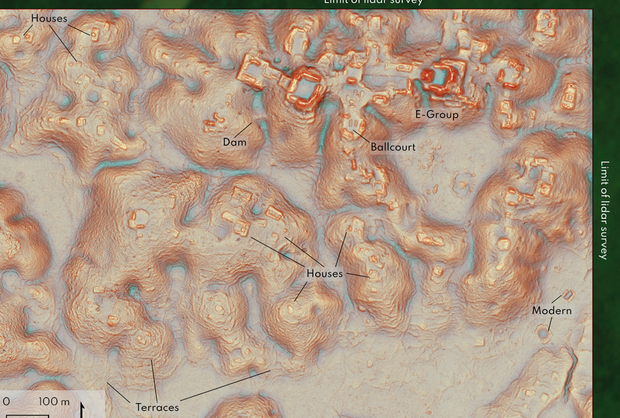CBS News
Hidden Maya city discovered in Mexico jungle by doctoral student: “There’s a lot more to be discovered”

A sprawling Maya city with palaces and pyramids was discovered in a dense Mexican jungle by a doctoral student who unknowingly drove past the site years ago on a visit to Mexico.
Tulane University archeology doctoral student Luke Auld-Thomas was in Mexico about a decade ago traveling between the town of Xpujil, an archaeology site, and coastal cities, when he drove past the unexplored settlements burrowed deep in the landscape.
But combing through those dense jungles needed the assistance of Lidar, a remote sensing technology that uses lasers to measure the distances of objects on the Earth’s surface.
And this can be very costly. Funders are often reluctant to invest in Lidar surveys in areas where no visible evidence of Mayan settlements exist, Auld-Thomas said.
But, several years later Auld-Thomas had an idea. He would use pre-existing surveys to find out if Maya civilizations could be located in these areas.
“Scientists in ecology, forestry and civil engineering have been using lidar surveys to study some of these areas for totally separate purposes,” says Auld-Thomas in a news release Tuesday. “So what if a lidar survey of this area already existed?”
Tulane University
In 2018, Auld-Thomas, an instructor at Northern Arizona University, located data collected in 2013 in a project spearheaded by Mexico’s Nature Conservancy to monitor carbon in Mexico’s forests. The previous team’s aim was to map above-ground carbon in forests.
The publicly available dataset allowed Auld-Thomas’ research team to identify the site as a terrain meriting further archeological investigation.
Over a period of five years, Auld-Thomas and his team analyzed everything remotely, using technology and analysis. And when Auld-Thomas analyzed that data, he stumbled onto a huge surprise — evidence of more than 6,600 Maya structures, including a previously unknown large city complete with iconic stone pyramids.
The team hadn’t anticipated discovering an ancient city that would put to rest persisting doubts among researchers that the Maya lowlands region was potentially not as populous and urbanized as researchers believed. It also validates previous research and puts an enduring question to rest.
“It does not reveal a different perspective on Maya urbanism and landscapes, it actually shows us that the perspective we already had is pretty accurate,” he said adding the “number of buildings present in the entire data set is high enough to speak of genuinely high regional scale population entities.”
Researchers published their findings on Tuesday in the journal Antiquity, describing the vast structures and buildings comprising the ancient city named “Valeriana” after a nearby freshwater lagoon. The team collaborated with Mexico’s Cultural Heritage Institute, local archaeologists, and the National Center for Airborne Laser Mapping at the University of Houston that enabled them to conduct the research remotely.
“This density is comparable to that of Mayan sites such as Calakmul, Oxpemul and Becán,” said Adriana Velázquez Morlet, director of Mexico’s National Institute of Anthropology and History Campeche Center, and one of the research’s co-authors, in a statement.
He added that their institute is working with local populations to ensure the new site’s conservation.
Auld-Thomas said that archaeologists who know the region well were able to improve the team’s analysis and provide “a really deep perspective on this region.”
Tulane University
“The nature of the ruins, the archeological buildings that were there — they were big and they were instantly recognizable as the kind of things that mark political capital of the Maya Classic period,” Auld-Thomas told CBS News.
The height of the Mayan empire was the Classic period, which spanned from approximately 250 A.D to at least 900 A.D., when they made breakthroughs in astronomy, hieroglyphic writings and the calendar system.
Arguably the most advanced civilization in the Americas, the empire once occupied what is now southern Mexico and northern Central America, including the countries of Guatemala, Belize, El Salvador and Honduras. Roughly 7 to 11 million people lived in the Maya civilization during this time, according to a 2018 study in the journal Science.
Auld-Thomas said his team analyzed 50 square miles, and found that the city of Valeriana — which was built before 150 AD — contains thousands of structures including palaces, temple pyramids, public plazas, a ballcourt, a reservoir and family homes. The technology allowed researchers to view archaeological settlements even in dense forest conditions in the southeastern Mexican state of Campeche.
Archaeologists in 2018 uncovered a massive network of Maya ruins hidden for centuries in the jungles of Guatemala. In 2022, human burial grounds and bullets from Spanish guns were discovered at a Maya city site in the country.
Auld-Thomas said the reason large parts of the Maya world are archaeologically unknown is because the region is so vast, leaving large swathes of it unexplored by researchers who then document its existence. Auld-Thomas said locals might have known about the structures, but the government and the larger scientific community did not.
“That really puts an exclamation point behind the statement that, no, we have not found everything, and yes, there’s a lot more to be discovered,” Auld-Thomas said in a Tulane University press release.
He also said the research underscored the value of open data in science, and that data gathered by someone in one discipline might prove useful for someone in a completely different research field.
“What I hope is that this encourages not only open data generally, but also collaboration between archeologists and environmental scientists going forward.”
CBS News
Saturday Sessions: Hippo Campus performs “Everything At Once”

Watch CBS News
Be the first to know
Get browser notifications for breaking news, live events, and exclusive reporting.
CBS News
Britain’s Conservative Party picks Kemi Badenoch as leader after crushing election defeat

Britain’s Conservative Party on Saturday elected Kemi Badenoch as its new leader as it tries to rebound from a crushing election defeat that ended 14 years in power.
The first Black woman to lead a major British political party, Badenoch (pronounced BADE-enock) defeated rival lawmaker Robert Jenrick in a vote of almost 100,000 members of the right-of-center Conservatives.
She got 53,806 votes in the online and postal ballot of party members, to Jenrick’s 41,388.
Badenoch replaces former Prime Minister Rishi Sunak, who in July led the Conservatives to their worst election result since 1832. The Conservatives lost more than 200 seats, taking their tally down to 121.
The new leader’s daunting task is to try to restore the party’s reputation after years of division, scandal and economic tumult, hammer Labour Prime Minister Keir Starmer’s policies on key issues including the economy and immigration, and return the Conservatives to power at the next election, due by 2029.
Alberto Pezzali / AP
“The task that stands before us is tough but simple,” Badenoch said in a victory speech to a roomful of Conservative lawmakers, staff and journalists in London. She said the party’s job was to hold the Labour government to account, and to craft pledges and a plan for government.
Addressing the party’s election drubbing, she said “we have to be honest — honest about the fact that we made mistakes, honest about the fact that we let standards slip.”
“The time has come to tell the truth, to stand up for our principles, to plan for our future, to reset our politics and our thinking, and to give our party, and our country, the new start that they deserve,” Badenoch said.
A business secretary in Sunak’s government, Badenoch was born in London to Nigerian parents and spent much of her childhood in the West African country.
The 44-year-old former software engineer depicts herself as a disruptor, arguing for a low-tax, free-market economy and pledging to “rewire, reboot and reprogram” the British state.
A critic of multiculturalism and self-proclaimed enemy of wokeness, Badenoch has criticized gender-neutral bathrooms and government plans to reduce U.K. carbon emissions. During the leadership campaign she drew criticism for saying that “not all cultures are equally valid,” and for suggesting that maternity pay was excessive.
Tim Bale, professor of politics at Queen Mary University of London, said the Conservative Party was likely to “swing towards the right both in terms of its economic policies and its social policies” under Badenoch.
He predicted Badenoch would pursue “what you might call the boats, boilers and bathrooms strategy …. focusing very much on the trans issue, the immigration issue and skepticism about progress towards net zero.”
Alberto Pezzali / AP
While the Conservative Party is unrepresentative of the country as a whole — its 132,000 members are largely affluent, older white men – its upper echelons have become markedly more diverse.
Badenoch is the Tories’ third female leader, after Margaret Thatcher and Liz Truss, both of whom became prime minister. She’s the second Conservative leader from a non-white background, after Sunak, and the first with African roots. The center-left Labour Party, in contrast, has only ever been led by white men.
In a leadership contest that lasted more than three months, Conservative lawmakers reduced the field from six candidates in a series of votes before putting the final two to the wider party membership.
Both finalists came from the right of the party, and argued they can win voters back from Reform U.K., the hard-right, anti-immigrant party led by populist politician Nigel Farage that has eaten away at Conservative support.
But the party also lost many voters to the winning party, Labour, and to the centrist Liberal Democrats, and some Conservatives worry that tacking right will lead the party away from public opinion.
Starmer’s government has had a rocky first few months in office, beset by negative headlines, fiscal gloom and a plummeting approval rating.
But Bale said that the historical record suggests the odds are against Badenoch leading the Conservatives back to power in 2029.
“It’s quite unusual for someone to take over when a party gets very badly beaten and manage to lead it to election victory,” he said. “However, Keir Starmer did exactly that after 2019. So records are there to be broken.”
CBS News
Saturday Sessions: Hippo Campus performs “Paranoid”

Watch CBS News
Be the first to know
Get browser notifications for breaking news, live events, and exclusive reporting.










